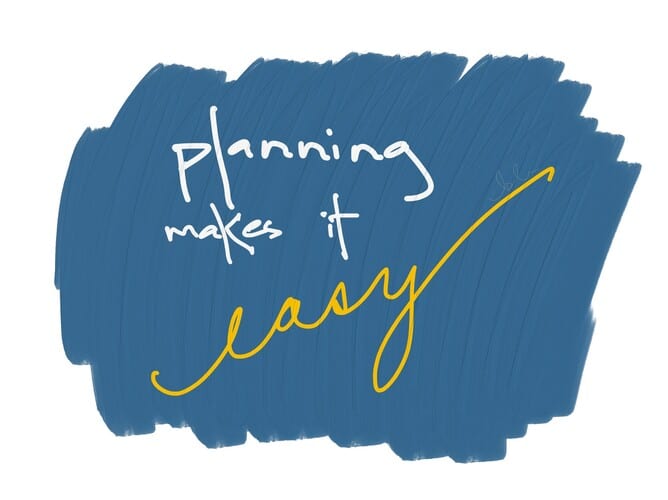This week I finished the DIY project of my downstairs bathroom. When I say “DIY”, this means “I hired a joiner to completely renovate the entire room and then I painted it”, which I say counts.
But actually that was part of the problem. I figured once the joiner had come in to strip the (weird geometrical shape) tiles on the wall, put in new flooring to replace the cold black tiles, add wood panelling and re plaster the walls…my part would be easy peasy, right?
After all, I had the paint. I’d found a great new company on instagram who sell the most beautiful paint based on colours on the Isle of Skye. I’d ordered tester pots and tried out the colours. I’d even ordered the painting tape so I could have nice clean edges. I had paintbrushes and rollers and paint trays and white spirit. I was all set!
Then it came to the day I was ready to start painting, and my tiny little project began to grow arms and legs.
I went to the shed to find the paintbrushes, and discovered I didn’t have those. I had one or two which weren’t the kind I needed, and I didn’t have any rollers. Last time I painted, I’d decided for the grand sum of a pound or two I could just throw away the roller and buy a new one next time. Well, now it was next time.
No problem, I thought, off to B&Q I go! Plus I could get a new light bulb for a lamp which I needed. So I head off, find the paintbrushes, the rollers, and a paint roller tray. Brilliant. …Except I got to the checkout and discovered the amazing roller tray with a sealable top was broken, so I had to go back and get another one. Okay. NOW I am all set. Head back home (realising I’ve forgotten the light bulb), and lay out all the painting things ready to go.
I reach for the paintbrush and the white paint to do the edging and the trim, and realise if I want the wood panelling to still be wood (and not white-paint-splattered), I need to tape every single edge of this tiny little bathroom which is pretty much all edges. So I pull out the painter’s tape and do that. I finish, and pull out the paintbrush again, and then realise I also need to paint the ceiling, which means more taping. Back to the tape. After a full hour of preparing the tape and making sure it’s not wonky, I’m worn out and don’t even feel like painting. But then the instructions on the painting tape remind me it’s better to remove the tape immediately after painting because you don’t want to have it on too long so, here we go. And I paint the ceiling and all the doorframes and the edging along the wood panelling and yay! Good job me! …oh yea. I need to do two coats.
This is how it went for several days. The roller tray I bought didn’t fit the rollers, and I had to angle it weirdly every time I went to put paint on it. It was REALLY hard to keep the dark blue paint from splattering on the fresh white paint, and I needed to leave several days for one colour to dry before I could switch to the other one. I decided to save the grand sum of ten pounds and not buy an extension for the roller brush because “it’s a small room and the ceiling isn’t that high and I’m pretty tall right?” Turns out ceilings are ceilings and it hurts to stretch to the very edges of a tiny bathroom standing on a side table because you don’t have a ladder.
By the time I was about halfway done, I was wondering why I imagined this would be a nice simple (maybe even fun) task. Just because it’s a small room doesn’t make it a small project. And I had forgotten about all the planning needed for any project like this.
The frustrations I had in the process didn’t come from the work being hard; they came because of my lack of planning. I didn’t stop to think how the taping would work, and which parts of walls to paint first. I didn’t check to see exactly what kind of paintbrushes I had (or didn’t), or measure the length of my roller and the height of my ceiling. I forgot the smallness of the room actually added to the complexity, and made it more difficult than painting a big wall.
Because when I finally got to the part where I was rolling the beautiful blue paint onto the walls, or painting the white doorframes, that was easy. That was relaxing and enjoyable. I didn’t even put any music on: just stood there with my paintbrush and went up, and down, and up, and down, and everything went smoothly and the paint was beautiful and I was nearly done.
And once the edges were tidied up and the paintbrushes returned to the shed and the floor cleaned; once I ordered the canvas prints for the wall and hung them; I stood looking at my DIY project and thought “Well that was fun! What room will I do next?”
I’m grateful our minds work this way. Halfway through a project (or a new business venture or writing a book or hiking a mountain), we’re stumbling and cursing and hungry and frustrated and wondering why we bothered. But when the paint dries and the canvas prints are up; when the books arrive fresh and beautiful in their boxes; when we stand at the top of the mountain and see the land laid out before us; that’s when we think, “Damn. I did that. Good job me! Let’s do another one.”
Otherwise, without that feeling of achievement and pride and enthusiasm, we’d never try again. And we wouldn’t learn to save ourselves a lot of hassle by planning properly next time.
I’ve already started planning my next painting project. I’m going to pick out the paint colour…but I’ll do a lot more than that this time. I’ll buy one of those metal edging tools so I don’t have to bother with painters tape. I’ll measure the walls and pay for the roller extension for the ceiling. Most of all I’ll remember that the more planning I do, the easier the project is.
We’ve been working this through at PF too. For years we’ve been holding team meets on Tuesdays, and the larger the team gets, the more there is to cover. When I show up without any planning, everything takes longer and we don’t cover all we need to and we get distracted by tangents. When I create a list of what we need to cover and am realistic about how long each section will take and who’s responsible for what, we achieve far more and the team meet is easy and enjoyable and energetic.
This applies to all our meets. Our team retreats. Client projects. New systems. Whatever the project is, the more planning you do, the more you can actually lose yourself in the project and enjoy it. There will still be surprises and confusions and things which don’t quite work, but the more planning you do, the easier it is to deal with these. For us planning includes:
- Looking at how much there is to cover and being realistic about the best way to work through each section. Is it a discussion? A breakout room? An action list? Silence and thinking? A brainstorm?
- Being honest about how long we expect it to take. If it’s a big change with strong feelings on all sides, a few minutes isn’t going to cover it.
- Setting timers and intentions. “For the next 15 minutes we’re going to cover this, and come up with three options.” When the timer goes off, move on to the next item. If we need more time, it goes into a future meet (or else we have to drop something off today’s list).
- Sending video updates ahead of time. One 3 minute video before an all team meet which everyone watches and is aware of saves 15 minutes of explaining, taking questions, double checking with everyone, and repeating yourself.
- Running the numbers. If we’re going to talk sales, we need to know exactly what we’re dealing with. What were our victories? Quotes out? Value? How many prospect calls did we have, and how did they go? What follow up was sent and when? The more information you have, the faster you can get to decisions.
- Divisional meet discussions before full team discussions. Before we bring something to the whole team, each divisional meet has already talked about it in their weekly meets. This helps everyone be fully heard and helps us see patterns quickly. If everyone has gotten to a similar conclusion before we bring it together, it makes it easy.
We’re continuing to read Atomic Habits by James Clear, and I’m loving the reminder to focus less on the goal and more on the rhythms and patterns which help you get there. The goal is good, but when you stare at the goal and focus on it, you can get discouraged. When you set the patterns, do the planning and the prep, achieving the goal feels a lot easier because it’s the accumulation of what you planned for.
What’s the last project you fired into and realised needed a bit more planning?





